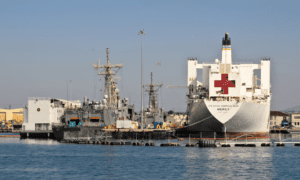Insurance losses to climb after Hurricane Ian hits Florida

Hurricane Ian will trigger billions of dollars in catastrophe insurance losses after bringing destructive winds and unprecedented storm surges as it reached the southwest Florida coastline at category four strength.
The hurricane made landfall at Cayo Costa, near Fort Myers on Wednesday night local time, with maximum sustained winds of around 240 kph, and then travelled slowly inland across the state causing further heavy rainfall.
“Some of the damage was almost indescribable,” Florida Governer Ron DeSantis said after viewing the coastal area. “I would say the most significant damage that I saw was on Fort Myers Beach. Some of the homes were wiped out, some of it was just concrete slabs.”
Guy Carpenter said Ian tied with Hurricane Charley in 2004 as the fourth-strongest hurricane to make Florida landfall, but Ian’s more destructive characteristics resulted in a broader area of excessive rainfall and storm surge height records in Naples and Fort Myers. The population of the region has risen since the earlier event.
Hurricane Charley would be an $US11-12 billion ($17-18.5 billion) insured loss in current dollars, based on 2004 exposures, Guy Carpenter says.
Insurance Information Institute Vice President Media Relations Loretta Worters said before the hurricane’s landfall that modellers were looking at extensive losses.
“While it’s too early to tell what the damage projections will be, many of the insurance modellers are putting it at between $US20 and $US40 billion ($31-62 billion), depending on the category storm, and where it hits,” she told USA Today.
The hurricane tracked northeast across Florida then regained category one strength after it emerged into the Atlantic Ocean. Ian is heading toward the South Carolina coastline and is expected to make landfall again on Friday local time.
Aon said it was too early to provide a definitive number on the expected volume of insured losses, with the threat still active and the final toll to be affected by demand surge, inflation and other factors.
Global Data says Hurricane Ian is likely to cause billions of dollars’ worth of losses and, coming after adverse weather events in the US earlier in the year, is likely to bring incurred losses in the nation’s fire and natural hazards market to near record levels.
“Combined with the losses from earlier in the year, Hurricane Ian is likely to leave insurers with their largest incurred loss since at least 2017 when a series of devastating hurricanes and wildfires took their toll on the country,” Associate Insurance Analyst Benjamin Hatton said.
“That year incurred losses in the fire and natural hazards line reached almost $US25 billion ($38.6 billion), with a loss ratio comfortably over 90%.”
The Insurance Information Institute says Hurricane Katrina in 2005 remains the costliest hurricane to hit the US, causing insured losses of $US89.68 billion ($138.4 billion), adjusted for inflation. That’s followed by Hurricane Ida last year at $US36 billion ($55.5 billion) and Sandy in 2012 with $US35.1 billion ($54.2 billion).
Harvey and Irma in 2017 each caused losses of around $US33 billion ($50.9 billion), with Maria the same year costing $US32.4 billion ($50 billion), the institute says.




